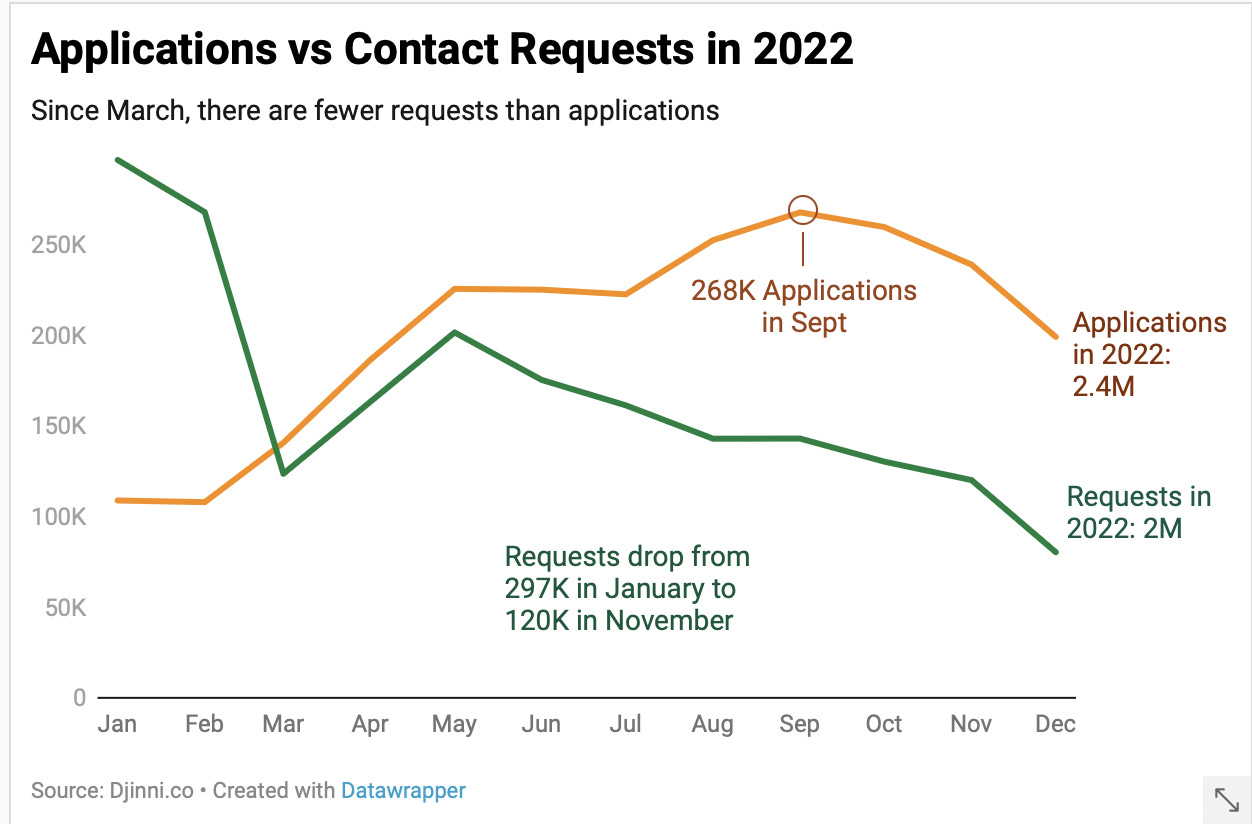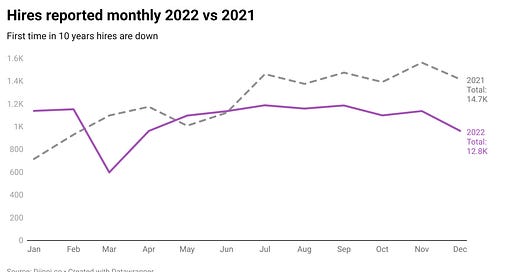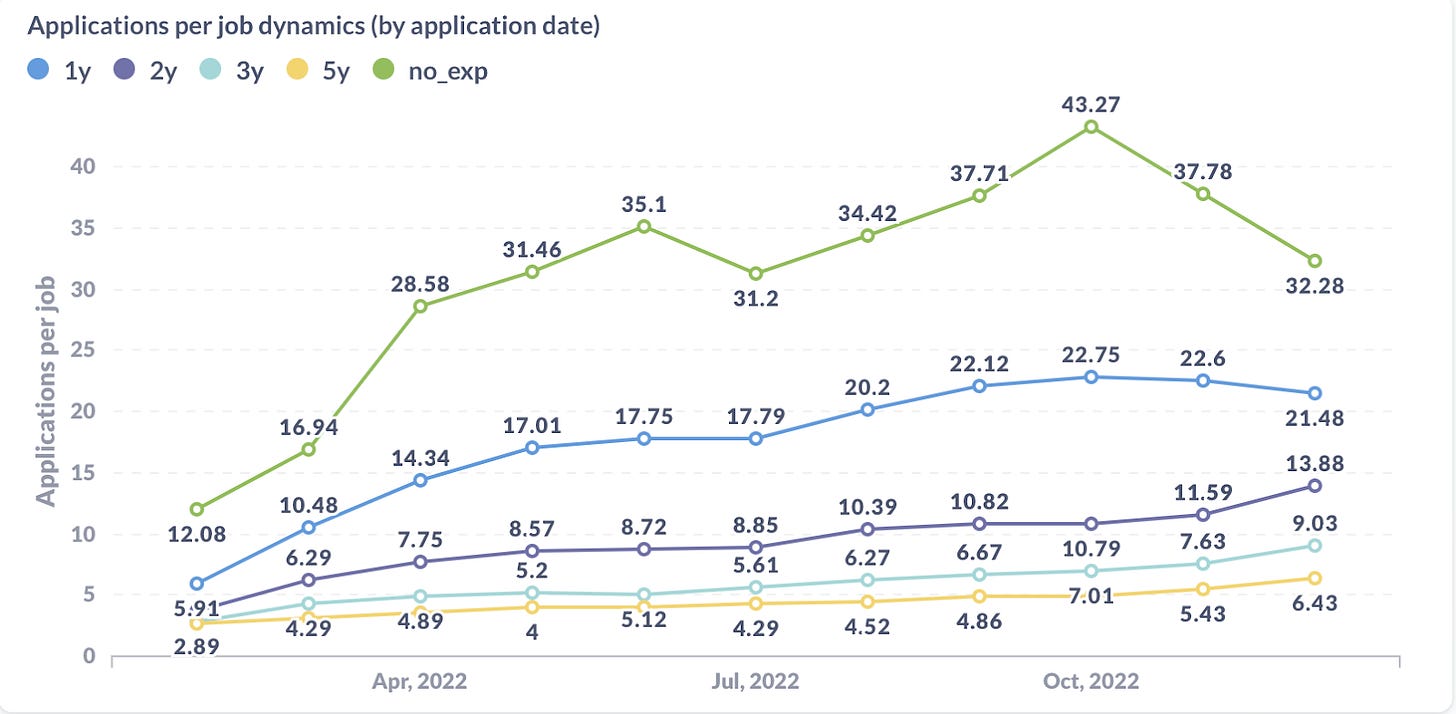The main event of 2022 was the war that still continues. Every sector of the Ukrainian economy felt its destructive power and IT was no exception. Despite significant changes and obstacles, the tech market was able not only to survive but also to operate on a stable level. The report by IT Ukraine Association indicates that in the 10 months of 2022, the industry brought $6 bn in export revenue, up 10% from the previous year.
We devoted the first week of 2023 to the analysis of the key changes in companies’ and candidates’ activities on Djinni, the biggest tech job marketplace in Ukraine, in order to understand what to expect from the year ahead.
Key takeaways:
The job market is now officially an employer’s market.
Hires are down by 13%. Given the circumstances, it could be worse.
The number of candidates online is up 2.5 times, largely due to switchers.
Monthly published jobs are down by 2x since January
Requirements for candidates increase
Salaries are maintained on the level of late 2021
Over 50% of jobs are fully remote
Hires are down by (only) 13%
For the first time in 10 years, there are fewer hires in 2022 than the year before.
Since May the number of hires monthly is stable, about 1K per month, which indicates a comforting prospect. In total, almost 12.8K candidates are reportedly hired on Djinni in 2022, 13% less than last year.
Considering the war and the crazy growth rates of 2021 it could be worse.
Specialists with 5+ years of experience are the most in demand. Their share in hires is about 35%. Candidates without experience constitute only 13% of reported hires (compared to 18% the year before).
Candidates online up 2.5 times
By the end of 2022, the number of candidates searching for a job (actively and passively) has reached a record mark of 77K. Starting in March it has been a steady +10K growth every three months.
This extraordinary increase is largely happening due to junior candidates’ and switchers joining the job market. The number of candidates online with little to no experience increased 4 times in a year (from 4,5K to 17,7K); in comparison, for candidates with 5+ years of experience, an index demonstrates ‘only’ 2x growth (from 14K to 25,9K).
The share of active candidates increased from 57% in January 2022 to 71% in December. On Djinni, active candidates are required to at least open messages from recruiters. Passive candidates are not actively looking for a job at this moment but will accept a lucrative offer.
New candidates’ registrations grew by 32%
In 2022, almost 59K new candidates registered and activated their accounts on Djinni. This number is 32% higher than in 2021.
The biggest growth was noted among candidates without experience (+45%).
The share of "newbies" in IT has grown from 25% in 2021 to 29% in 2022; candidates with 5+ years of experience still represent a quarter of all registrations.
Before September 2022 there were more jobs published monthly than candidates activated.
Why is the number of candidates online growing? It takes longer to find a decent position due to a lack of new opportunities, consequently, profiles stay active for longer.
Jobs published monthly dropped from 35K in January 2022 to 20K in March 2022 and, eventually, to 12K in December 2022. The number of activated candidates stays on the same level of 17-18K per month; with notable drops to 15K in both February and April 2022.
Jobs published monthly declined by 2x since January
In 2022, recruiters published 168K unique vacancies, 10% less than in 2021. The plunge in monthly publications is more dramatic: from 34,5K in January 2022 to 16K in November.
The number of new jobs created in 2022 is 15% less than in 2021.
80% of jobs published on Djinni in 2022 require at least 2 years of experience. This number has increased since 2021, indicating growing demand for experienced candidates.
The share of vacancies with no requirement for specific experience fell from 5.3% to 3.9%. The share of new jobs for the top specialists increased from 13 to 20%.
Among the top categories, the number of new jobs is down for most specializations except C++ and Node.js.
Job applications grew 3x
The number of job applications increased almost 3 times (2.4M vs 806K in 2021). The market is upside down in comparison to the situation in 2021. 2022 will be to a great degree dominated by employers’ demand.
In September we saw a new absolute high: 268K job applications in a month.

With the drop in published vacancies, the average number of applications per job first increased to 16 in September and is now slowly going down from there.
Candidates became less picky in choosing a job to apply for
The number of weekly applications per thousand views increased by 40% from an average of 70 in January to 100 in December.
The competition among trainees becomes incredibly tough
Since there are fewer jobs for inexperienced candidates, the number of applications from these candidates skyrocketed in 2022. It increased from 12 applications per job in February to 43 in October and is gradually lowering since then.
The median monthly number of applications for ‘no experience’ jobs increased from four in January-February to ten in the next months. The skewness in this metric indicates that some jobs have higher competition than others. The most competitive positions are junior QA and Javascript developers. At some point, there were up to 500-800 candidates online per job opening.
Eight out of ten vacancies that received the highest number of applications were for QAs; another two — were for JavaScript developers. These were the jobs that required no previous commercial experience (trainees, interns).
The highest number of applications received by a job posting in 2022 was 1786 (!).
Requests from recruiters are down by 2.5x from January
Requests are messages from recruiters with a proposition to open candidates’ contacts. A drop from almost 300K requests in January to 120K in November indicates that recruiters don’t feel the shortage of applications.
On average, 30K candidates per month received requests from recruiters, with a peak of 34K in November. The average number of messages per candidate monthly dropped from 12 in 2021 to 4-6 in 2022.

Candidates with 5+ years of experience receive 50% of all the messages from recruiters throughout the two years. Only about 8% of all messages are sent to candidates with less than 2 years of experience.
The response rate improved by 60%
In 2021 the response rate of candidates fell by 50% due to the increased number of messages from recruiters. In 2022 the market changed dramatically and candidates became more responsive. Since there are fewer messages, candidates respond to a bigger share of them — 35-37%.
Passive candidates are less responsive – their response rate is 11% vs more than 50% for candidates in active search.
According to our Telegram poll, only 25% of respondents changed a job in 2022 compared to 46% in 2021. 60% are working in the same company and 15% are looking for a job.
Salaries increased for senior tech candidates
The median salary of hired candidates increased this year for almost all segments, especially for experienced tech professionals. For newcomers and candidates without experience, the median remains at a modest $500.
At the same time, salaries were not changing much during 2022. Rather they stayed on the level of late 2021 after a remarkable rise in the second half of the year.
Fastest growing salaries in 2022: Scala, Data Engineer, Salesforce, Flutter, DevOps.
Median salaries for Golang, .Net, Android and Node.js did not change since last year.
Highest salaries: Lead, Scala, Rust, Golang, Java.
The share of hires with a salary of $5K and more raised from 4% in January 2021 to 18% in October 2022. There were 192 hires for $8000 or more in 2022, up from 63 in 2021.
Remote work trends: candidates can choose
At the beginning of the full-scale war, the share of fully remote positions increased from 27% to 55%, but in December it shrank to 48%. The ‘candidate can choose’ option started to gain popularity after attacks on Ukraine’s energy infrastructure in October. Companies equipped their offices with generators and Starlinks so that employees can work during blackouts. Office jobs also increased from 5 to 7% in December.
Relocation perspectives from international companies are draining out
In March, companies from outside Ukraine created 380 jobs on Djinni. Almost 40% of them had the option of relocation. However, this opportunity gradually exhausted itself: in October, there were only 10% of relocation options available, and in December — 12% (taking into consideration fewer job openings overall).
Poland remains the most popular country for relocation, the same as a year before.
10% of jobs are unavailable for Ukrainian candidates
The share of Ukrane-only job postings fell from 43% in June to 37% in December. In October we introduced the search option for candidates in the European job market, excluding Ukraine. The share of such vacancies is now about 11%.
As for international companies, they are more actively searching worldwide (46% instead of 26% on average). They do not specifically search for Ukraine-based candidates (14% vs 37%).
Candidates from 130 countries
This year we blocked all candidates from russia and belarus. Yet, the share of candidates from Ukraine dropped from 82 to 76%. The drop can be partially explained by the massive relocation trend among IT specialists, especially females, because of the war. On the other hand, we have put some effort into expanding Djinni’s presence in international markets.
Top 5 countries where active candidates are logging into Djinni in 2022 are:
Ukraine 76%
Azerbaijan 5%
Nigeria - 3%
Poland - 2.6%
Armenia - 1.4%
We did two surveys about relocation in our telegram channel. The one in March showed that 12% of tech professionals have already relocated. In November the number increased to 20% (with only half of them willing to return). About 38% want to relocate but do not have an opportunity under martial law. The same amount of participants says they will not go anywhere even if such an option presents itself further down the line.
Our data also shows an increased number of candidates who change the country in their profile from Ukraine to another one. Most often candidates choose Poland and Germany.
Djinni is the most popular job site among Ukrainian developers
73% of developers believe that Djinni is the most effective way to land a new job, according to a survey on DOU.ua. Almost a quarter of IT professionals who participated in a survey found their current position on Djinni (up from 19% from last year).
Conclusion
2022 was rough.
Despite all the challenges of war, Ukrainian IT managed to adapt with the help of relocations, energy-independent offices, the will of companies and employees to keep working and a strong commitment to providing the best possible services.
The job market turned upside down with more people wanting to enter the stable industry with higher salaries. There are fewer job openings and fewer proposals from recruiters. According to layoffs.fyi, 1020 tech companies laid off almost 154K employees in 2022. Yet, there is still work to be done. This can become an opportunity for growth for Ukrainian IT with its relatively cheap and very skilled talent pool.
The future depends on the demand for IT services in global markets and on the success of the Ukrainian Armed Forces. So we help the Armed Forces and believe in our victory.
Thank you for reading.
Follow us on LinkedIn for more data and market insights.























